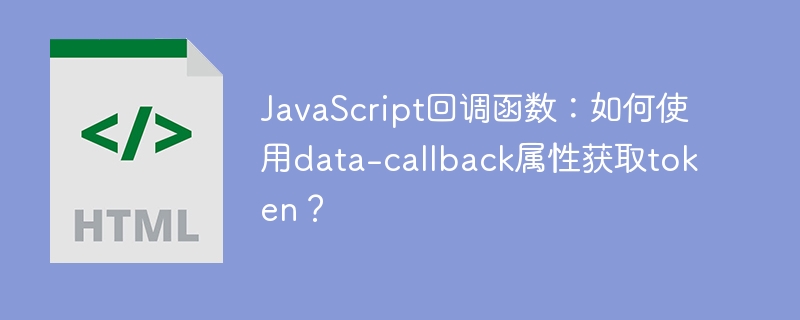 Web Front-end
Web Front-end
 HTML Tutorial
HTML Tutorial
 JavaScript callback function: How to get token using data-callback attribute?
JavaScript callback function: How to get token using data-callback attribute?
JavaScript callback function: How to get token using data-callback attribute?

Use JavaScript callback function to process data-callback attribute to get token
In front-end development, callback functions are a common mechanism for handling asynchronous operation results when interacting with third-party services. This article<div class="cf-turnstile" data-callback="javascriptCallback" data-sitekey="yourSitekey"></div> As an example, illustrates how to obtain the token returned by data-callback attribute through JavaScript.
In the code<div> The element uses the <code>data-callback attribute, whose value is javascriptCallback , indicating that the element depends on a JavaScript function named javascriptCallback to process the callback results. data-callback property usually specifies a function called after a specific event (for example, third-party service verification is successful). In this example, the javascriptCallback function expects to receive a token as a parameter, but the code does not directly define the function.
Key: Check third-party service documents
To obtain a token, be sure to consult the official documentation of third-party services . The document will explain in detail how to use data-callback attribute, including the parameter type and meaning of the callback function.
If the document information is insufficient, we can infer that javascriptCallback is likely to be a global function defined under window object. Therefore, we can manually define the function to receive and process callback results:
window.javascriptCallback = (...args) => {
// Use the extension operator (...) to receive all parameters console.log(args); // Print all parameters to facilitate checking tokens
// Assume that token is the first parameter const token = args[0];
if (token) {
console.log("geted token:", token);
// Use the obtained token
} else {
console.error("token not obtained");
}
}; This code defines an arrow function called javascriptCallback , using the extension operator ...args receives all parameters, prints the parameters to check whether the token exists. Assume here that token is the first parameter, the actual situation may be different and needs to be adjusted according to the third-party service documents. Finally, the code determines whether the token exists and performs the corresponding operation. This method allows you to capture and use data-callback attribute token returned in JavaScript.
The above is the detailed content of JavaScript callback function: How to get token using data-callback attribute?. For more information, please follow other related articles on the PHP Chinese website!

Hot AI Tools

Undresser.AI Undress
AI-powered app for creating realistic nude photos

AI Clothes Remover
Online AI tool for removing clothes from photos.

Undress AI Tool
Undress images for free

Clothoff.io
AI clothes remover

AI Hentai Generator
Generate AI Hentai for free.

Hot Article

Hot Tools

Notepad++7.3.1
Easy-to-use and free code editor

SublimeText3 Chinese version
Chinese version, very easy to use

Zend Studio 13.0.1
Powerful PHP integrated development environment

Dreamweaver CS6
Visual web development tools

SublimeText3 Mac version
God-level code editing software (SublimeText3)

Hot Topics
 1359
1359
 52
52
 What is the purpose of the <progress> element?
Mar 21, 2025 pm 12:34 PM
What is the purpose of the <progress> element?
Mar 21, 2025 pm 12:34 PM
The article discusses the HTML <progress> element, its purpose, styling, and differences from the <meter> element. The main focus is on using <progress> for task completion and <meter> for stati
 What is the purpose of the <datalist> element?
Mar 21, 2025 pm 12:33 PM
What is the purpose of the <datalist> element?
Mar 21, 2025 pm 12:33 PM
The article discusses the HTML <datalist> element, which enhances forms by providing autocomplete suggestions, improving user experience and reducing errors.Character count: 159
 What is the purpose of the <meter> element?
Mar 21, 2025 pm 12:35 PM
What is the purpose of the <meter> element?
Mar 21, 2025 pm 12:35 PM
The article discusses the HTML <meter> element, used for displaying scalar or fractional values within a range, and its common applications in web development. It differentiates <meter> from <progress> and ex
 What is the viewport meta tag? Why is it important for responsive design?
Mar 20, 2025 pm 05:56 PM
What is the viewport meta tag? Why is it important for responsive design?
Mar 20, 2025 pm 05:56 PM
The article discusses the viewport meta tag, essential for responsive web design on mobile devices. It explains how proper use ensures optimal content scaling and user interaction, while misuse can lead to design and accessibility issues.
 How do I use HTML5 form validation attributes to validate user input?
Mar 17, 2025 pm 12:27 PM
How do I use HTML5 form validation attributes to validate user input?
Mar 17, 2025 pm 12:27 PM
The article discusses using HTML5 form validation attributes like required, pattern, min, max, and length limits to validate user input directly in the browser.
 How do I use the HTML5 <time> element to represent dates and times semantically?
Mar 12, 2025 pm 04:05 PM
How do I use the HTML5 <time> element to represent dates and times semantically?
Mar 12, 2025 pm 04:05 PM
This article explains the HTML5 <time> element for semantic date/time representation. It emphasizes the importance of the datetime attribute for machine readability (ISO 8601 format) alongside human-readable text, boosting accessibilit
 What is the purpose of the <iframe> tag? What are the security considerations when using it?
Mar 20, 2025 pm 06:05 PM
What is the purpose of the <iframe> tag? What are the security considerations when using it?
Mar 20, 2025 pm 06:05 PM
The article discusses the <iframe> tag's purpose in embedding external content into webpages, its common uses, security risks, and alternatives like object tags and APIs.
 What are the best practices for cross-browser compatibility in HTML5?
Mar 17, 2025 pm 12:20 PM
What are the best practices for cross-browser compatibility in HTML5?
Mar 17, 2025 pm 12:20 PM
Article discusses best practices for ensuring HTML5 cross-browser compatibility, focusing on feature detection, progressive enhancement, and testing methods.



